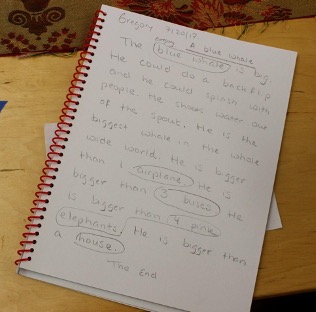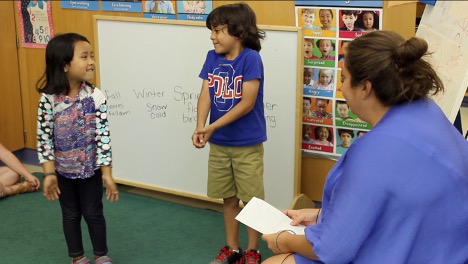Introduction

Storytelling/Story Acting (STSA) is a simple movement based on the work of Vivian Paley. STSA involves children dictating stories to adults, followed by a teacher-facilitated acting out of children’s stories at meeting times throughout the day. STSA develops narrative fluency, the concept of a story, and the opportunity to express emotions and experiences. There is no need for rehearsal or special props and stories can be acted out anywhere. It is however, important to designate a “stage” and develop a routine around STSA.
Roll Out
Narrative Development
Children typically follow a natural progression of narrative story development. One and two-year-olds tell stories with one or two events. Three-year-olds tell stories that usually follow a “leap frog” pattern, detailing many events that may or may not follow a logical order or be related. Four-year-olds typically tell stories as a chronology, linking many events with “and then.” Children who are five years old most commonly tell narratives that end at a high point. Six-year-olds can tell more classic narratives with more developed examples of a beginning, middle and end to their story.
Getting Started
Before students and teachers begin STSA, it is helpful to engage in storytelling and story acting separately, naming these activities for children. Students should be encouraged to share stories at Morning Meeting, while Journaling, and through individual and small group conversations. Teachers should model telling their own stories orally during transitions, in conversations, and at group meeting times. After read-alouds, teachers should encourage students to think about what the stories might look and sound like if the children were to act them out. Teachers can write down their own story and read it to the group and talk about acting it out. Eventually, these can be the first stories to practice story acting. Familiar and favorite storybooks can also be used as an introduction to story acting and be acted out using the basic Story Acting format outlined below.
Materials
The materials for STSA are simple. The adult taking dictation needs a writing utensil and something to write on. A simple piece of paper will do, or the teacher could keep a classroom journal of STSA stories. Likewise, students could have their own individual STSA journals to keep their stories over time and show progression. Props, costumes, etc. are not necessary and in many cases complicate the process. This is not the same as putting on a play; rather the Story Acting component is a vehicle for quickly making children’s narratives come to life and expand children’s engagement with stories in their classroom community.
Scheduling
SEE encourages teachers to begin STSA in November, once the children have become comfortable with the classroom routines and expectations. When rolling out STSA, teachers may notice that some children are more interested than others, this is natural and may change over time. Establishing a posted weekly or rotating schedule so that each child gets a STSA day where they dictate a story to a teacher and have their story acted out is recommended. This schedule provides all students with opportunities for STSA and allows them to begin planning for their story but teachers can also spontaneously take a story from a child who really needs to tell one. All stories should be acted out on the same day they are told. Incorporating the whole STSA cycle on the same school day assures that no one’s work gets lost, and validates student language.
Model Lessons
Dictation Modeling & Introduction
Materials
- STSA paper
- Writing utensil
Connection (Provocation)
At circle time or in a small group:
Lately, I’ve heard many of you telling stories to your friends. Today I’m going to show you how we do storytelling
Name It! This is…
This is Story Telling Story Acting.
Guided Discovery: (Explicit Instruction)
Use paraprofessional as model for ST.
Guided Discovery
I want to show you how to tell a story. Then, once you have told the story and I have it written down, we will come back to the class and everyone will act it out together! Watch carefully to notice how story telling will take place.
- First, I’m going to call you over to come work with me. “Ms. Smith would you like to tell me a story?”
- Then, I will write the date on a blank piece of paper. I might ask you if you have any ideas for your story. “Do you know what you want to tell a story about today? Yes, ok great.”
- Then you’ll start telling me a story (Para starts her story. Maybe once upon a time.) And as you tell me your story, I’m going to write down all of the words that you say. (Model doing this.)
- Sometimes you may talk a little too fast and I’ll ask you to slow down or repeat something so that I make sure I have all of your words on the paper.
- When I’m writing and the words get close to the bottom of the page, I’m going to warn you that the story has to end soon because I’m running out of room.
- Then, when your story is finished, I’ll read your story back to you. When I’m reading the story back to you I’ll point to the words so you can see them. When I’m reading, if you want the words to say something different, or if you want to add words, or take some away, you can tell me then and we can edit the words together.
- Once we have finished editing, I’ll ask you if this story has a name or a title, and you can name it whatever you’d like.
- After it has a title, I’ll ask you which character you’d like to be in your story. Next, we’ll determine how many other characters there are in your story.
- Later we will act your story out with the class.
Send-Off
Remind students ….
- If you would not like to tell a story, that’s ok. You can tell me, “No thank you”.
- Your story can only be one page long.
- Try to be patient with the grown up writing your words. Often we speak faster than anyone can write.
Story Acting Modeling & Introduction
Materials
- STSA Journal
- “Stage” area (most helpful if marked off from Audience area)
Connection (Provocation)
At circle time:
This morning you all told some amazing stories. Let’s review some expectations for acting those stories out so we can celebrate your writing.
Name It! This is…
This is called “Going to the Theater” or Story Acting
Guided Discovery: (Explicit Instruction)
(Teachers can do this lesson all at once, or spread it out over many days.)
Guided discovery –
Now that we have some amazing stories written down, it’s time for me to show you how we will act them out, and for us to agree upon some expectations for going to the theater.
- First, you may notice some tape on the floor. This tape is showing the line between the stage and the audience. The stage is where actors perform, and the audience is the people who are watching the performance. In this case for Story Acting, the only way you can come on the stage is if the person reading the story invites you. Just like at the theater, audience members can’t just run up on stage! If an audience member did that they would be kicked out of the theater, and would miss the show.
- Now who has ever been to the theater before? (Many children have been to the movie theater, some may have seen live shows. Discuss the differences between the two but acknowledge the similarities.) I notice many of you have been to some theater before, remind me what are the rules or the expectations for going to the theater? (Generate and refine together, expect a list similar to:
- Respect the show
- Stay in your seat
- Hands in your lap
- Quiet mouth
- Applaud when the show is finished
- Tell children that these will be the expectations for audience members in your classroom theater.
- Now, let’s talk about the actors on the stage, there are some important things for our actors to remember. First, you must be invited onto the stage. When the narrator is reading the story, she may pause, look at you and whisper in a soft voice to invite you to be a character. If you would like to be that character you may join the other actors on stage. If you would not like to be that character you can kindly say, “pass”.
- Once you choose to be a character there are two important things to keep in mind. The first, is that you have to consider what acting like that character might look like. If you are acting as a tree you might show your branches and have a long, tall trunk. (Demonstrate for students). A tree would look very different than if you were acting as a fish swimming around. (Demonstrate for students). Would you like to practice what it might look like to be an actor? (Students stand up, acquire sufficient space on the rug for acting). Show me what it might look like if you are acting as a dog! Show me if you are a race car! Show me a teacher! Good, let’s take a seat.
- Now that you’ve practiced acting out some things, it’s important to remember that when you are acting, there will be many other children also being actors. What might the expectation be?
- Have a safe and careful body
- Sometimes, friends may tell a story that involves two characters using their hands or bodies in ways that don’t follow our classroom expectations about having safe and careful bodies. Some stories may include hitting or kicking. It’s okay for stories to include this, but we certainly don’t want to hurt any friends while we’re acting. How could we be good actors while also following classroom expectations? (Field answers like pretend to hit one another, play fight. Decide on an expectation of pretend fighting a full arms-length away from the other actor. Ideally, you could fit a grown up in between the “fighting” space. Establish this under the safe and careful body expectation).
- Now that you know how to be safe and careful actors, and respectable audience members, are you ready to try story acting?
Send-Off
Remind students ….
- They can only enter the stage if they are invited.
- Politely saying, “pass” is acceptable if they do not want to participate.
- If someone gets to play the role you wanted, you will get a turn to act another time.
- Actors only pretend.
- Respectful audiences clap or applaud at the end of every performance.
